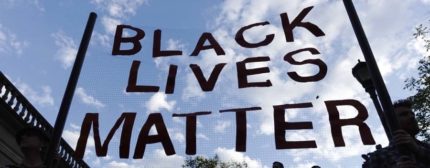
Kim Keenan, president and CEO of the Multicultural Media, Telecom, and Internet Council, answers questions after speaking about an initiative to train volunteers around the country on the best ways to use cell phones to videotape law enforcement. (AP Photo /Jacquelyn Martin)
WASHINGTON (AP) — Civil rights groups are planning to train a legion of volunteers on how to record police encounters in minority neighborhoods in hopes that fear of being videoed will deter misconduct like illegal shootings of unarmed men and women.
The Multicultural Media, Telecom and Internet Council and other groups officially announced the Santana Initiative on Thursday, which will train citizens on their rights to record police interactions with the public.
The recording of the deaths of several Black men at the hands of police, including Walter Scott, Philando Castile and Eric Garner, has made police relations with minority communities a national topic, said Kim Keenan, the MMTC president. Video becomes a tool to help prosecute wrongdoing or even clear police officers when they are in the right, she said.
“So, we have to have a way to record this, so the truth comes out,” Keenan said.
The program, which is being supported by groups like the NAACP, the League of United Latin American Citizens, the National Newspaper Publishers Association, U.S. Black Chambers of Commerce and the National Congress of Black Women, is named after Fieden Santana, who in 2015 recorded the fatal police shooting of Walter Scott in South Carolina.
Former police officer Michael Slager said he started shooting after Scott attempted to grab his Taser. But Santana’s video showed Slager shooting Scott after the Black man started running away. Slager pleaded guilty in May to violating Scott’s civil rights and is awaiting sentencing.
“We know we have to do a better job of documenting these types of crimes, and the best way to do that is to make sure people know what their rights are and are prepared with information,” said Brent Wilkes, executive director of the League of United Latin American Citizens.
The MMTC has already posted on its website guidelines on how to legally film public police interactions, http://www.mmtconline.org/wp-content/uploads/2017/07/Santana-Initiative-FAQs-FINAL-071817.pdf, vetted pro bono by the legal firm Akin Gump Strauss Hauer & Feld LLP. In addition, it plans to train volunteers to learn how to legally record people trying to intimidate minorities at voting places or trying to keep people from showing up to vote.
“We want to give them the tools they need to pull out their phones with confidence,” Keenan said.
Police have increased the use of cameras in their cars and body cams in their interactions with the public, but they control whether those are being used and what happens to the video, Keenan said.
International outrage followed this week after an Australian woman was shot dead by a Minneapolis officer responding to her 911 call. Justine Damond had called 911 twice Saturday evening to report a possible sexual assault behind her home. The responding officers did not turn on their body cameras until after the shooting, and the squad car camera was also not activated.


